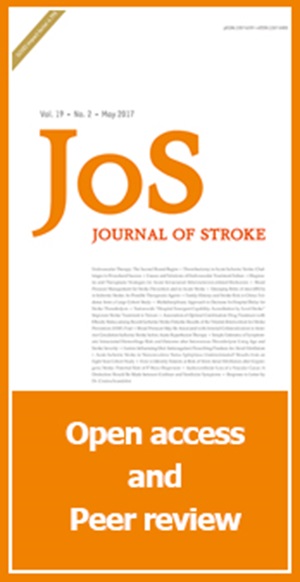急性缺血性卒中合并非瓣膜性心房颤动患者早期给予依多沙班:一项随机试验。
IF 6
1区 医学
Q1 CLINICAL NEUROLOGY
引用次数: 0
摘要
本文章由计算机程序翻译,如有差异,请以英文原文为准。
Early Administration of Edoxaban After Acute Ischemic Stroke in Patients With Non-valvular Atrial Fibrillation: A Pilot Randomized Trial.
Without anticoagulation, the risk of early recurrence in the first 14 days after atrial fibrillation (AF)-related ischemic stroke is approximately 0.5%–1.3% per day. Anticoagulation is an essential strategy for preventing recurrent stroke in patients with AF-related stroke. However, it increases the incidence of intracranial hemorrhage (ICH) in the early stages of stroke. For the timing of anticoagulation, the “1–3–6–12 days rule” has been used: administration of anticoagulant at day 1 for transient ischemic attack (TIA), day 3 for mild stroke (National Institutes of Health Stroke Scale [NIHSS] <8), day 6 for moderate stroke (NIHSS 8–16), and day 12 for severe stroke (NIHSS >16). However, this rule was established when vitamin K-dependent anticoagulation was used. Non-vitamin K-dependent oral anticoagulants (NOACs) have a similar efficacy and are associated with a lower bleeding risk; they may be administered earlier than warfarin in patients with acute ischemic stroke (AIS). However, no randomized controlled trials have focused on the timing of NOAC administration in patients with AF-related AIS. The purpose of this study was to examine the feasibility and possible efficacy of NOAC administration at timepoints earlier than the conventional rules. Considering that early recurrent infarcts identified using diffusion-weighted imaging (DWI) and ICH identified using gradient-echo imaging (GRE) are common in patients with AF-related AIS, we used these imaging endpoints in this pilot study. This was a multicenter, randomized, open-label, blinded endpoint trial. Patients with AIS identified by DWI were included if they (1) were ≥20 years old, (2) had cardioembolic infarction (due to AF) identified before randomization, (3) had mild to moderately severe stroke (TIA and severe strokes were excluded), and (4) could be administered edoxaban within 48 hours of symptom onset. The exclusion criteria are summarized in Supplementary Table 1. Patients were randomized to either the conventional edoxaban treatment group (C-group) or the early edoxaban treatment group (E-group). In the C-group, a standard dose of edoxaban was administered to patients on day 3 for mild stroke and on day 6 for moderate stroke after symptom onset. Before administration of edoxaban, the use of anticoagulants was prohibited. In the E-group, a half-dose of edoxaban was administered from onset until day 3 (for mild stroke) or day 6 (for moderate stroke), and a standard dose of edoxaban was then administered as in the C-group. Baseline magnetic resonance imaging (MRI) was performed 24–48 hours after symptom onset, and follow-up MRI was performed between days 10 and 14. MRI images, including DWI, GRE, fluid-attenuated inversion recovery, and magnetic resonance angiography, were collected at the Asan Medical Center Central Image Laboratory and read by neuroradiologists blinded to treatment allocation. Thrombolysis or endovascular therapy was permitted if appropriate. Edoxaban was administered 24 hours later to patients who received thrombolysis therapy. This trial was performed in accordance with the Good Clinical Practice guidelines and approved by the Institutional Review Boards of all participating centers. Written informed consent was obtained from all patients (clinicaltrials.gov–NCT03433235). The primary outcome was the occurrence of new symptomatic Letter to the Editor Journal of Stroke 2023;25(2):311-314 https://doi.org/10.5853/jos.2023.00325
求助全文
通过发布文献求助,成功后即可免费获取论文全文。
去求助
来源期刊

Journal of Stroke
CLINICAL NEUROLOGYPERIPHERAL VASCULAR DISE-PERIPHERAL VASCULAR DISEASE
CiteScore
11.00
自引率
3.70%
发文量
52
审稿时长
12 weeks
期刊介绍:
The Journal of Stroke (JoS) is a peer-reviewed publication that focuses on clinical and basic investigation of cerebral circulation and associated diseases in stroke-related fields. Its aim is to enhance patient management, education, clinical or experimental research, and professionalism. The journal covers various areas of stroke research, including pathophysiology, risk factors, symptomatology, imaging, treatment, and rehabilitation. Basic science research is included when it provides clinically relevant information. The JoS is particularly interested in studies that highlight characteristics of stroke in the Asian population, as they are underrepresented in the literature.
The JoS had an impact factor of 8.2 in 2022 and aims to provide high-quality research papers to readers while maintaining a strong reputation. It is published three times a year, on the last day of January, May, and September. The online version of the journal is considered the main version as it includes all available content. Supplementary issues are occasionally published.
The journal is indexed in various databases, including SCI(E), Pubmed, PubMed Central, Scopus, KoreaMed, Komci, Synapse, Science Central, Google Scholar, and DOI/Crossref. It is also the official journal of the Korean Stroke Society since 1999, with the abbreviated title J Stroke.
 求助内容:
求助内容: 应助结果提醒方式:
应助结果提醒方式:


